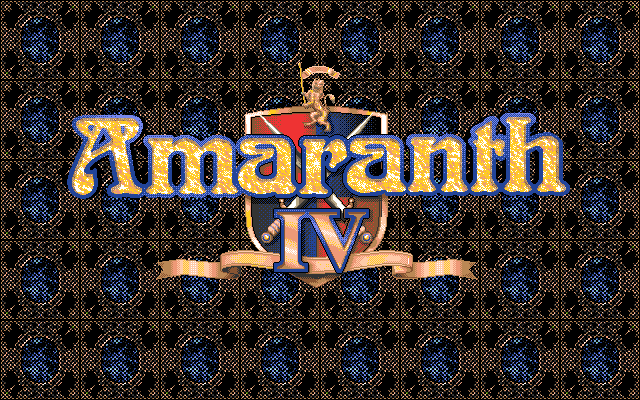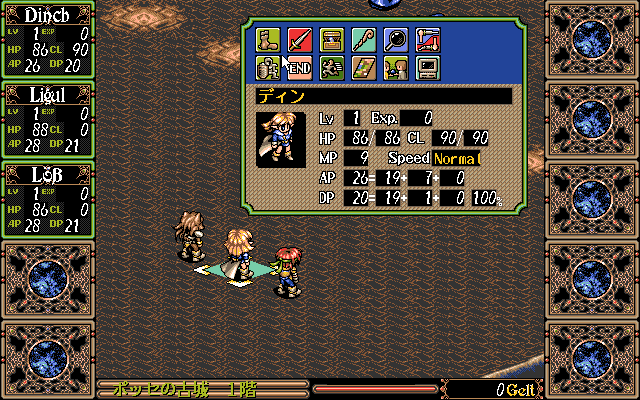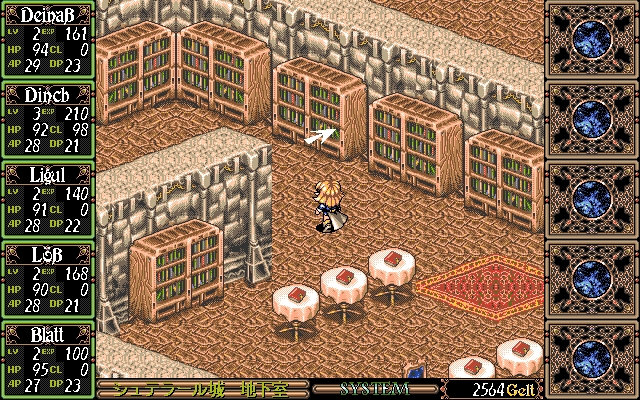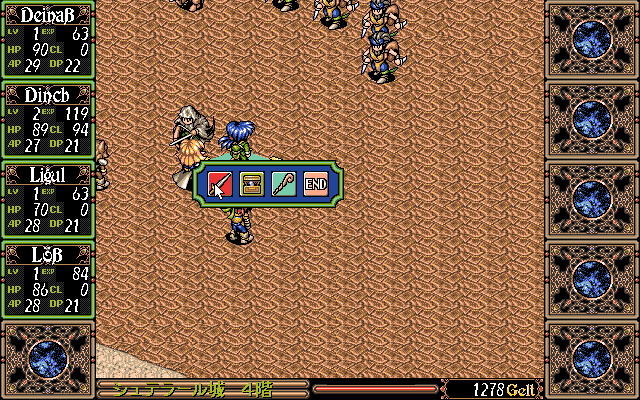Retro Replay Review
Gameplay
Amaranth IV refines the series’ signature strategy RPG mechanics by embracing a streamlined turn-based system. Gone are the complex vigour and action point gauges of its predecessor, replaced by a straightforward scheme: each character may move and perform a single action—be it a physical strike or a spell—per turn. This design choice not only accelerates the flow of combat but also encourages players to think more tactically about positioning and skill usage.
(HEY YOU!! We hope you enjoy! We try not to run ads. So basically, this is a very expensive hobby running this site. Please consider joining us for updates, forums, and more. Network w/ us to make some cash or friends while retro gaming, and you can win some free retro games for posting. Okay, carry on 👍)
Weapon mechanics add an extra layer of depth. Melee weapons allow for direct confrontations, while bows demand precise diagonal placement to strike foes from a distance. Magic users, meanwhile, occupy versatile roles, casting area-of-effect or single-target spells depending on their repertoire. With each victory, characters earn experience points and level up, growing more formidable over time. Downed allies are automatically revived at full health after battle, ensuring the party remains ready for the next encounter.
Exploration is purposely limited to key locations, mirroring the narrative-driven structure of Amaranth IV. While open-world detours are few, each environment—from the ancient ruins of Posse to the bustling streets of Stellar—serves a clear purpose in advancing the plot. Battles are woven seamlessly into the story, occurring at pivotal moments rather than as random encounters, which keeps tension high and progression focused.
Graphics
Amaranth IV’s shift to an isometric perspective breathes new life into both combat and exploration. Detailed tile-based maps showcase lush forests, crumbling stone walls, and regal palaces with crisp clarity. Character sprites are richly animated, transitioning smoothly between idle stances, dynamic attack motions, and spellcasting flourishes.
The visual design of Posse, with its vine-wrapped columns and ancient murals, contrasts beautifully with Stellar’s gleaming towers and marble plazas. Each locale feels distinct, thanks to thoughtful color palettes and environmental effects like drifting dust motes or ambient light filtering through stained glass windows. These touches not only enhance immersion but also aid navigation during exploration segments.
Spell animations stand out as highlight moments on the battlefield. Fiery crescents, shimmering healing orbs, and crackling lightning arcs punctuate skirmishes with flair. Even minor actions, such as drawing a bow or shrugging off minor wounds, are accompanied by satisfying visual cues. Overall, the game’s aesthetic strikes a fine balance between classic pixel art charm and modern polish.
Story
Amaranth IV continues the overarching saga of the series, shifting focus from long-time hero Liann Fremdes to his compassionate elf companion, Din. Having forged a bond with Prince Deinass eight years prior—during events chronicled in the previous installment—Din returns to Stellar with fresh resolve. Their reunion rekindles memories of past sacrifices and loyalty, setting the stage for renewed adventure.
When Deinass’s sister is abducted by an old acquaintance, the kingdom faces its darkest hour yet. Din, Deinass, and a cadre of allies must navigate political intrigue and ancient rivalries to rescue the princess. Along the way, players encounter new personalities—soldiers, mystics, and rogue scholars—each adding depth to the narrative tapestry. Themes of redemption, trust, and the enduring power of friendship resonate throughout their journey.
Dialogue is well-paced, with character interactions that reveal motivations and personal stakes. Cutscenes, rendered in the game’s signature art style, punctuate major story beats and heighten emotional impact. Whether unraveling royal conspiracies in dimly lit chambers or exploring forgotten temples, the narrative consistently ties back to Din’s unwavering determination and the bonds she shares with her companions.
Overall Experience
Amaranth IV successfully marries accessible gameplay with a rich, character-driven story. Its simplified combat mechanics make it approachable for newcomers to strategy RPGs, while the nuanced weapon placements and spellcasting options offer satisfying tactical choices for veterans. Rare, story-tied battles ensure each skirmish feels meaningful, avoiding the grind common in the genre.
The game’s visuals and audio work in concert to create an inviting fantasy world. Atmospheric soundtracks underscore moments of tension or triumph, and detailed backgrounds invite players to linger in each setting. Although exploration is more confined than in some RPGs, the tight narrative focus keeps pacing brisk and compelling.
Ultimately, Amaranth IV stands as a worthy successor in its beloved series. By centering on Din’s heroism, introducing fresh characters, and refining core mechanics, it delivers a memorable adventure that both fans and newcomers will appreciate. If you seek a strategic RPG with an engaging plot, dynamic battles, and a touch of classic charm, this journey to Stellar is one you won’t want to miss.
 Retro Replay Retro Replay gaming reviews, news, emulation, geek stuff and more!
Retro Replay Retro Replay gaming reviews, news, emulation, geek stuff and more!









Reviews
There are no reviews yet.